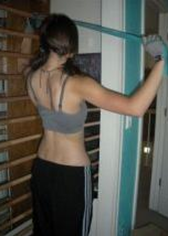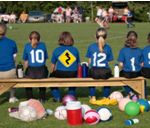BRACE & SCHROTH Treatment
Treatment Method
Traditionally, in the US, therapy has been considered to be ineffective in treating scoliosis. However the Schroth method is a more advanced pattern-specific 3-dimensional treatment that is beginning to demonstrate positive results as suggested in the study of Otman et.al. (see below).
Schroth Method is a non surgical, conservative treatment program for scoliosis consisting of curve-specific exercises and corrective breathing techniques. The Schroth Method then incorporates a unique technique called ‘rotational’ or ‘rotatory’ breathing. Simply stated, the patient is taught to breathe into the concave side of the trunk in order to rotate the ribs allowing them to return to a more “normal” physiological position. Then in the ‘exhalation’ phase of Schroth, patients are taught 3D stabilization to help restore a more stable three-dimensional spinal alignment. This helps the patient experience the feeling of the corrected spinal posture in order to recognize how to maintain it. Patients are taught to use this postural awareness during daily activities.
Because both The LA BraceTM and Schroth method view the scoliosis as a 3-dimensional problem and use techniques to address the 3-dimenional mis-alignments, the two systems work perfectly in tandem to provide the best possible results. Beginning Schroth treatment prior to bracing, helps to loosen up tight soft tissue, making adapting to the brace easier. Then when you discontinue your brace wear, continuing to do Schroth exercises allows you to maintain the corrections achieved by The LA BraceTM and Schroth.
Unfortunately there are only a handful of certified Schroth therapists in the US. For more information on how to get Schroth therapy treatment.
More information on The LA BraceTM can be found at www.TheLABrace.com
LA 2-Brace System with Schroth Method
The new 2-brace LA brace system is the perfect companion to Schroth method. The 2-brace system combines the standard pattern-specific LA brace with a secondary low profile exercise brace. This second brace stabilizes only in certain areas to allow for the combination of stability and postural corrections. We classify scoliosis into 10 different patterns and for each pattern we have a 2-brace system available. We believe the 2-brace system in combination with the Schroth method represents the Gold standard for conservative treatment of scoliosis.
Otman S, Kose N, Yakut Y The efficacy of Schroth s 3-dimensional exercise therapy in the treatment of adolescent idiopathic scoliosis in Turkey
METHOD: We carried out this study with 50 patients whose average age was 14.15 +/- 1.69 years at the Physical Therapy and Rehabilitation School, Hacettepe University, Ankara, Turkey, from 1999 to 2004. We treated them as outpatients, 5 days a week, in a 4-hour program for the first 6 weeks. After that, they continued with the same program at home. We evaluated the Cobb angle, vital capacity and muscle strength of the patients before treatment, and after 6 weeks, 6 months and one year, and compared all the results. RESULTS: The average Cobb angle, which was 26.1 degrees on average before treatment, was 23.45 degrees after 6 weeks, 19.25 degrees after 6 months and 17.85 degrees after one year (p<0.01). the vital capacities, which were on average 2795 ml before treatment, reached 2956 ml after 6 weeks, 3125 ml after 6 months and 3215 ml after one year (p<0.01). similarly, according to the results of evaluations after 6 weeks, 6 months and one year, we observed an increase in muscle strength and recovery of the postural defects in all patients (p<0.01). CONCLUSION: Schroth technique positively influenced the Cobb angle, vital capacity, strength and postural defects in outpatient adolescents. The 2-brace system has the additional benefit of giving kids a lower profile brace to wear during school hours thereby making compliance less of an issue. Adolescents make up the majority of patients for whom The L.A. BraceTM is utilized. However other age groups can also be treated with The L.A. BraceTM but require a different approach.




